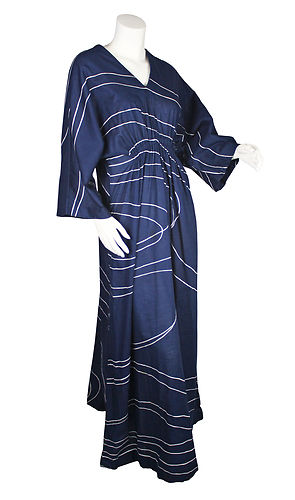Old, new, whatever, get whatever Marimekko you can (and give it to me).
A old catalog shot from the Design Research days.
I’ve written about other vintage brands that were once great but now exist only in a sad, zombie form (Esprit, White Stag), or brands that shone brightly before fading out in a slow crescendo of shoulder pads and empire waists (Lanz). Marimekko, on the other hand, is the Prince of clothing labels; it started out as a genius innovator, settled into legend status, and continues to quietly blow minds, even if it’s not necessarily in the limelight. At least, unlike Prince, Marimekko discovered cross-brand collaborations instead of Jehovah.
The company, which started in the 1960s in Finland, has always been known for its bright, colorful patterns involving stripes, flowers, and/or abstracts. Originally, the main store was Design Research in Cambridge, MA, which is why so many of that era’s liberal professionals--a.k.a., hippies who’d grown up and gotten advanced degrees and real jobs--were outfitted in their bold, floral shifts and tucked their young kids into the iconic Bo Boo bedding, the sheets adorned with cars and trucks.
A more low-key fabric in a still-fabulous style. Now on ebay, and FYI, I have a birthday coming up.
Having always gone strong in Europe, Marimekko’s popularity faded in the US for a while; at one point in the late ‘90s, the main source for Marimekko in New York was a small, second floor retail space that mainly stocked their fabrics, and those are mostly intended for use as upholstery or for framing. You could still find their old dresses and tops in vintage stores, or, if you were me, in your parents’ basement. Since I have the default style-sensibility of an infant--bright! shiny! gimme!--the basement was never enough, and I was always on the hunt for all the Marimekko I could find, even if a lot of those vintage dresses were so ‘60s and smock-like they could pass for maternity (or, given the loud colors, a circus tent).
At the turn of the century, however, Marimekko made a move to get its mojo back in the US by selling through Crate & Barrel again (which is what Design Research became) and allowing franchises to open. Now the brand has official retail stores, like the flagship on 23rd Street near Madison Square Park, which sells not just the old sheets and housewares, but the clothes, many of which are takes on the classic fabrics and designs. Marimekko also started doing limited-run collaborations with Converse, Anthropologie, and even H&M.
A contemporary design that, minus the gloves, I would also really like for that upcoming birthday.
These attempts to branch out have been great, because, despite the risk of over-licensing the brand (see, again, Esprit), they’re also rare opportunities to buy Marimekko at a more reasonable price, since vintage pieces are usually priced as collectibles. Though nothing about the brand is cheap. I realize it’s a classic label junkie’s excuse, but for as much as Marimekko costs, these babies are built to last; I’m still wearing my mother’s cotton, not-faded dresses from fifty (sweet Jesus!) years ago, and their simple canvas totes and handbags take a beating without much visible wear and tear. Not that the garments’ durability will stop me from stalking vintage stores and online sales, if only so I can pass my own set on to my future daughter (or, more likely, one of my nephews if one of them turns out gay, fingers crossed).
Credits, from top: Slow and Steady Wins the Race, Ebay, Marimekko US





 A Black Balloon Publication ©
A Black Balloon Publication ©